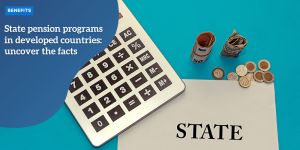What Public Sector Workers Need to Know: Social Security Fairness Act and Pension Benefits Update

Anúncios
Understanding the Social Security Fairness Act
Overview of the Law
On January 5, 2025, a new law known as the Social Security Fairness Act was signed, bringing significant changes to Social Security benefits for millions of public sector workers.
This pivotal legislation puts an end to the Windfall Elimination Provision (WEP) and the Government Pension Offset (GPO), provisions that long diminished or cut off Social Security benefits for more than 3.2 million workers with non-covered pensions.
This change is a monumental step forward in ensuring equity and fairness in Social Security benefits.
Impact on Individuals with Non-Covered Pensions
The end of WEP and GPO provisions directly affects individuals who receive pensions from employment not covered by Social Security.
Anúncios
Previously, these workers faced reductions or eliminations in their Social Security benefits simply because their employment did not require paying Social Security taxes.
With the Fairness Act, these individuals can now look forward to receiving full Social Security benefits.
This change is set to bring financial relief and fairness to over 3.2 million people affected by these provisions.
| Group | Before the Fairness Act | After the Fairness Act |
|---|---|---|
| 👩🏫 Teachers | Pensions from non-covered employment with limited benefits | Pensions from non-covered employment increase with rightful Social Security benefits |
| 🚓 Firefighters and Police Officers | No Social Security benefits from non-covered pension systems | Full Social Security benefits without penalties |
| 🏛️ Federal Employees | Under the Civil Service Retirement System (CSRS) with limited alignment | Aligned benefits with those in covered employment |
| 🌍 Individuals with Foreign Social Security Systems | Worked in foreign social security systems with no US benefits | Now eligible for US Social Security benefits through foreign agreements |
Eligibility and Benefit Changes
Impact on Non-Covered Pensions
The Social Security Fairness Act, effective January 5, 2025, brought remarkable changes primarily for those with non-covered pensions.
Anúncios
Beneficiaries who are mostly composed of teachers, firefighters, police officers, and federal employees covered under the Civil Service Retirement System (CSRS), will see a substantial shift in their Social Security benefits.
However, it is crucial to note that only individuals with non-covered pensions — meaning pensions based on work that did not include Social Security taxes — will see these benefit increases.
Public Employees Not Affected
Despite widespread excitement, this change does not impact all public employees.
A significant 72% of state and local public employees work in roles covered by Social Security and pay into the system.
These employees are not subject to the Windfall Elimination Provision (WEP) or Government Pension Offset (GPO).
Therefore, their benefits remain unchanged due to the new law.
Potential Benefit Increases
For those affected, the benefit increases can vary considerably.
Several factors contribute to how much an individual’s monthly benefit could rise, including the type of Social Security benefit they receive and the amount of their non-covered pension.
Here’s a snapshot of potential changes:
As we move forward, it’s essential for beneficiaries to stay informed and engaged with updates regarding their specific situation.
Keeping personal information current within the Social Security Administration is vital to ensure smooth processing of the new adjustments.
Implementation Timeline and Payment Schedule
This section will provide a detailed look at the implementation timeline for the law, retroactive benefits, and the process for automated versus manual case processing.
Retroactive Benefits
Retroactive benefits are payable starting from January 2024.

Even though the law was signed in January 2025, the Windfall Elimination Provision (WEP) and Government Pension Offset (GPO) no longer apply to benefits payable from January 2024 forward.
This means the Social Security Administration (SSA) will issue a one-time retroactive payment covering the benefits from January 2024 to the start of the new payments in April 2025.
Beneficiaries can expect these retroactive payments to be deposited by the end of March 2025.
New Monthly Benefit Amounts
Beginning April 2025, beneficiaries will start seeing the new monthly benefit amounts for their March 2025 benefits.
These adjusted benefits reflect the elimination of WEP and GPO.
For many, this will result in a significant increase—some seeing over $1,000 added to their monthly Social Security checks.
It’s essential to wait until April before inquiring about the status of retroactive payments, as they will be processed incrementally throughout March.
Automated vs. Manual Case Processing
To handle the volume of adjustments needed, the SSA uses automation to expedite payment processing.
This method is efficient, processing most cases automatically.
However, some complex cases require manual processing, which takes additional time.
The SSA anticipates that some of these manual cases could take up to a year to complete.
Beneficiaries should remain patient and wait for mailed notices explaining their benefit changes.
Expected Timeframes
-
⏳ Retroactive payments: By end of March 2025
-
📅 New monthly benefit amounts: Starting April 2025
-
⚙️ Automated case processing: Immediate, up to March 2025
-
🔧 Manual case processing: Up to one year for complex cases
With these adjustments in place, keep your details up-to-date and monitor your SSA communications to ensure smooth processing of your new benefits.
Next, it’s important to familiarize yourself with the required actions you need to take as a beneficiary.
This knowledge ensures you receive your benefits correctly and promptly.
Required Actions for Beneficiaries
With the Social Security Fairness Act putting an end to the Windfall Elimination Provision (WEP) and Government Pension Offset (GPO) provisions, beneficiaries need to take specific steps to ensure they receive the new benefit adjustments smoothly.
Here’s a detailed guide on what actions you should take.
Verifying and Updating Contact and Direct Deposit Information
To enable the Social Security Administration (SSA) to process your new benefit amounts and any retroactive payments seamlessly, ensuring your contact and direct deposit information is accurate and up to date is crucial.
Here are the steps to verify and update that information:
- Online Verification:
- Log into your my Social Security account.
- Check that your mailing address and direct deposit information are correct.
- Phone Verification:
- If you can’t access your account online, you can verify your information by calling SSA at 1-800-772-1213.
Ensuring these details are current allows you to receive your new benefit amounts without delay.
Applying for Benefits if You Never Applied Due to WEP or GPO
If you never applied for retirement, spouse’s, or surviving spouse’s benefits because of the WEP or GPO reductions, you may now be eligible.
Here’s how to proceed:
- Filing for Retirement or Spouse’s Benefits:
- The easiest way to apply is online at the SSA website.
- Alternatively, call 1-800-772-1213 for assistance. When prompted, say “Fairness Act” to connect to a representative trained in handling WEP-GPO cases.
- Filing for Surviving Spouse’s Benefits:
- This application is not available online. Call SSA at 1-800-772-1213.
- When the system prompts, say “Fairness Act” to be directed to the appropriate representative.
Instructions for New Applicants
When you apply for Social Security benefits, the application process may still require you to provide pension information; however, your benefits will not be offset due to WEP or GPO.
The SSA will ensure that your new benefits reflect the Fairness Act adjustments without penalties from the repealed provisions.
By following these steps, beneficiaries can smoothly transition to receiving their new Social Security benefits. Remember, SSA provides these services free of charge, and you should be cautious of any fraudulent activity.
For a deeper dive into related concerns, let’s move on to the next pertinent aspects.
Medicare Premium Considerations
Changes in Medicare Premium Payment Methods After Benefit Adjustments
The Social Security Fairness Act has implemented significant changes for workers affected by the repeal of the Windfall Elimination Provision (WEP) and Government Pension Offset (GPO).
One of these changes involves Medicare premium payments. If you previously paid your Medicare premiums to the Centers for Medicare & Medicaid Services (CMS) directly because your Social Security benefits were reduced, here’s what you need to know.
Starting now, your Medicare premiums will be deducted directly from your new, adjusted monthly Social Security benefits.
Until you receive an official notice from the Social Security Administration (SSA), you should continue following the payment instructions on your Medicare premium bill to ensure there is no interruption in your coverage.
Once the benefit adjustments are made to your Social Security record, you’ll be notified by SSA that your premiums will now be deducted automatically.
If you had prepaid premiums, any applicable refunds will be processed once your Social Security benefits start covering the premiums.
Handling Existing Premium Payment Arrangements
If you are using Automated Clearing House (ACH) payments, also known as Medicare Easy Pay, you will need to discontinue these payments.
Here’s how:
- Complete the Authorization Agreement for Preauthorized Payments form (SF-5510).
- Send the form to the address provided on it, or submit it online at Medicare.gov.
Additionally, if you use an online bill payment service directly through your bank, make sure to contact your bank to stop these payments once your premiums are deducted from your Social Security benefits.
If you need assistance, you can call 1-800-MEDICARE (1-800-633-4227).
Guidance for CSRS Annuity Recipients Regarding Premium Deductions
If your Medicare premiums were previously deducted from your Civil Service Retirement System (CSRS) annuity, those will now be deducted from your newly adjusted Social Security benefits.
The SSA will send you a notice with detailed information regarding this change. Should you have any questions about your specific premium deductions, reach out to the SSA for clarification to ensure a smooth transition.
These adjustments to your Medicare premiums and benefit payments underscore the SSA’s commitment to improving financial fairness following the repeal of the WEP and GPO.
Protecting Against Scams and Fraud
Warning Signs of Potential Scams Related to the Social Security Fairness Act
As the Social Security Fairness Act aims to provide financial relief to over 3.2 million public sector workers, it’s crucial to stay vigilant against potential scams that could arise.
Unfortunately, whenever significant sums of money change hands, opportunistic scammers are likely to follow.
Here are key warning signs to watch out for:
-
🚨 If anyone calls you claiming to be from the Social Security Administration (SSA) and asks for payment in order to receive or expedite your benefits, hang up immediately. SSA will never ask or require you to pay for assistance or to have your benefits started, increased, or paid retroactively.
-
⚠️ Be wary of unsolicited emails or messages offering to help you navigate changes due to the Social Security Fairness Act in exchange for personal information or money. Legitimate communication from SSA will not request sensitive information through these channels.
-
🔗 Do not click on links or download attachments from emails or messages that seem suspicious or promise a quicker pathway to receiving benefits.
The SSA has taken measures to inform the public about these potential scams and to protect beneficiaries.
Callers to SSA’s National 800 Number are greeted with a recorded message about the Act which helps to mitigate hold times and reduce the likelihood of fraudulent interactions.
Reporting Suspicious Activity
If you suspect that you’ve encountered a scam relating to the Social Security Fairness Act, it’s essential to report it promptly.
The SSA recommends taking these steps:
Takeaways
Navigating the changes introduced by the Social Security Fairness Act requires attentiveness and caution against fraud.
Always remember, SSA communicates changes transparently and never through demands for payment.
By staying informed and vigilant, beneficiaries can safely secure the benefits they are entitled to.






